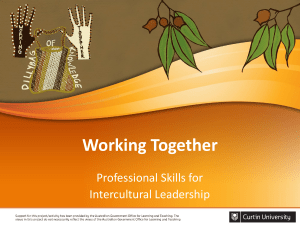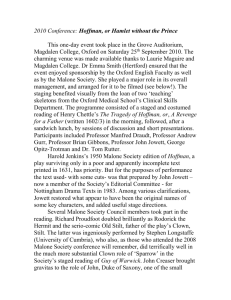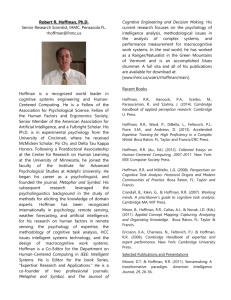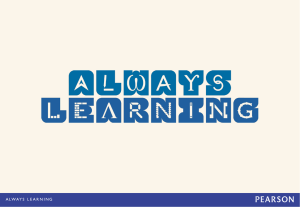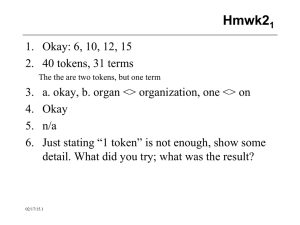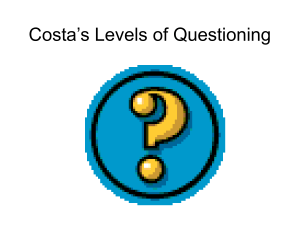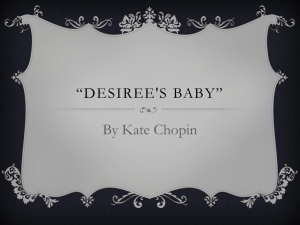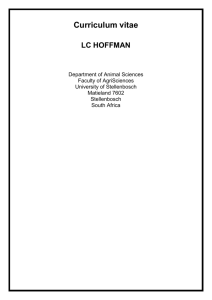You
advertisement
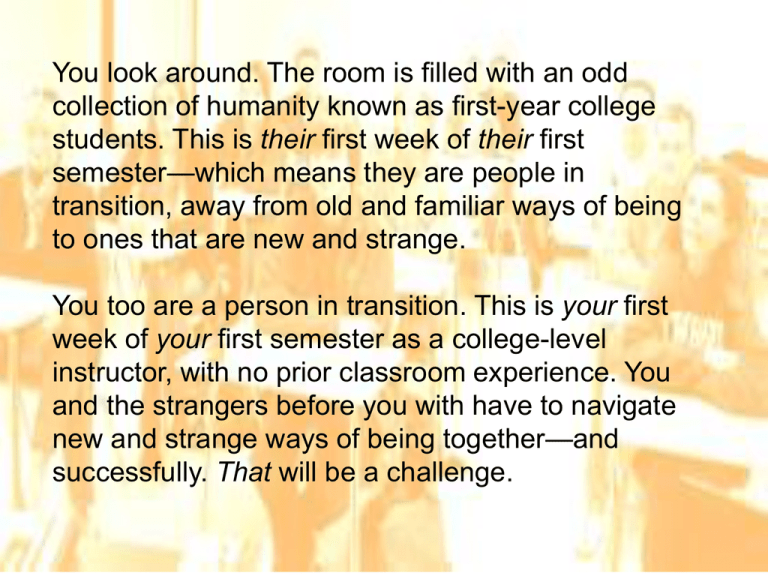
You look around. The room is filled with an odd collection of humanity known as first-year college students. This is their first week of their first semester—which means they are people in transition, away from old and familiar ways of being to ones that are new and strange. You too are a person in transition. This is your first week of your first semester as a college-level instructor, with no prior classroom experience. You and the strangers before you with have to navigate new and strange ways of being together—and successfully. That will be a challenge. Mastering your jitters, you look out at the faces before you. You hope for signs that they will be good material to work with. But those signs are sometimes hard to spot. Ms. Zhang and Xue sit quietly in back. Ms. Xue whispers to Ms. Zhang while Ms. Zhang sizes you up with an expressionless stare. Seated a couple of desks in front of them, Cezar Martinez bows over his notes, scribbling. To his right, Venkat and Kushagra argue about their prior class. “It is! It is!,” Venkat asserts, thumping his desk. “No. It is not!”Kushagra objects, lifting his chin for emphasis. To their right Irina Kozlova sits erect with a book laying open on her desk, a novel. She reads, glances up every now and then to see what signals you are sending, and then continues to read. To her left, Jack, a latecomer, slides into a desk on the front row and slouches. He yawns and glances at the desk next to him, then at the girl sitting at the desk next to him. Perhaps he can find a way to impress her. That girl, Carol, not to be impressed, sits amending notes in a spiral-bound notebook. Sensing Jack’s encroaching glaze, Carol shifts, quartering her shoulder away from him and frowning as she bites her pencil. It looks like you have your work cut out for you. It is 10:03 AM. Everyone seems to be here. Time to get started? What should you do? 1) Take a few minutes to engage in small talk about life outside the classroom, yours and theirs. [If this is your choice, skip to the next slide.] 2) Jump right in to the day’s discussion. If you finish with time to spare, you can let the class out early. [If this is your choice, skip to slide #11.] You: Boy, the weather was beautiful this weekend. Got out to the auto show at Wind Rock Mall. Anyone get out there too? [looks around at the faces]…No? [pauses] Hope that doesn’t mean you all stayed inside… Irina: I went to Acoma…the Sky City. You: Acoma? That’s a pretty interesting place. Not your typical student attraction. How did you happen to go there? Irina: My classmate’s parents took us there. They live here. You: Oh, well, did you enjoy it? Irina: It was okay, interesting. The food was good. You: Good food? That’s essential! Anyone else do something fun this weekend? Carol: I went to Sandia Crest. You: Sandia Crest? Beautiful view up there. Did you ride the cable car? Carol: No. We hiked a lot. Down the east side. You: Lot of good trails on the east side. Stay away from the west side, though— unless you like heat stroke and Gila monsters. Why didn’t you ride the cable car? Carol: I’m afraid of heights. You: Afraid of heights and you went to Sandia Crest? Like to face your fears? Good for you! By the way, I never ride the cable car either. Too scary!…. Anyone else? Jack: I went to a rave. (Watching closely to see the your reaction.) [Some students snicker. Carol rolls her eyes and turns to frown at Jack.] Venkat: [aside to Jack] The professor doesn’t know what a rave is! You: [without missing a beat] A rave? Dark room, flashing light, sleepless night? Can’t say for sure, Jack, but you may get your fill of sleepless nights cramming for exams and writing papers. The beginning of the semester is when you should get outside and enjoy the weather. [slight pause] Speaking writing papers, for today you were to read Diane Hoffman's " Culture and Self in Multicultural Education" and we should probably get down to the business of discussing it… Now that you’ve transitioned to the day’s discussion, what should your discussion strategy be? 1) Stimulate discussion with open-end questions, encouraging student-to-student exchanges, helping all to connect topics that come up with real-world experience—and as opportunities present themselves, weave in references to things that came up in small talk. This will show that you listen when they talk and help them connect the classroom with the real world. [If this is your choice, skip to slide #??.] 2) Stimulate discussion with open-end questions, encouraging student-to-student exchanges, and helping all to connect topics that come up with real-world experience. The small talk, having helped break the ice, is best left behind: bringing it into the discussion proper is much too risky. [If this is your choice, skip to slide #??.] You: Okay, let’s get started. For today you were to read Diane Hoffman's " Culture and Self in Multicultural Education." As I said last time, we will be exploring some the voices in the debate over multiculturalism as an educational reform. Can someone give us a brief summary of Ms. Hoffman’s main point? [A long silent pause] Anyone? [The long pause continues. Students squirm and fidget.] Ms. Zhang: She is for it? You: “She is for it?” Is that a question or a statement? Ms. Zhang: She is for it…I think. Ms. Xue: I agree. You: You agree? Okay. With what do you agree…that Hoffman is for multicultural education? [Ms. Zhang tightens her lips, wondering what you are fishing for. The Ms. Xue falls silent and stares at her feet.] Jack: I thought the article jumped around and never really got to a point. I didn’t like it; it was boring. You: Okay. Let’s see…So far, we have some who say Hoffman “is for it,” some who agree, and some who thinks she jumps around and never comes to a point. Is anyone willing to take a stab at telling us just what it that Hoffman says? … Did everyone read the article? [Looks around at blank stares. Some student nod; other do not.] Okay…it’s early in the semester…this process is new for most of you…and it looks like we’re getting off on the wrong foot… YouYou: address of getting offyou on the by Hoffman's " Okay,the let’sproblem get started. For today werewrong to readfoot Diane Culture and Self in Multicultural Education." As I said last time, we will be exploring some the voices in the debate overa multiculturalism as an 1) Saying something like, “We should take moment to settle down and educational Canissomeone us a brief summary Ms.Ms. Hoffman relax. The goalreform. for today to havegive a conversation about of what Hoffman’s says—in the main samepoint? way we might talk about, say, a TV program. This is strange and new material I know for all of you. One of the benefits of a [A long silent pause] course like this is to give you practice getting your head around and talking about strange and new material. That’s what college is often about. Life too. Anyone? “It might help us to spend a little time getting to know each other, so that’s what we’ll do. Now,continues. see if weStudents can put squirm these desks in a circle.” [If this is your [The long pause and fidget.] choice, skip to the next slide.] Ms. Zhang: She is for it? You: “Shethe is for it?” Is that athe question or a statement? 2) Lecturing class about importance of doing the reading and Ms. Zhang: is fortoit…I think. the articles. You also remind them that 10 coming to classShe ready discuss Ms. Xue: I agree. percent of their grade depends on the quality of their class participation. You: You agree? Okay. With what do you agree…that Hoffman is for Having done that, you reinitiate the discussion and hope for better results. multicultural education? [If this is your choice, skip to slide #??.] [Ms. Zhang tightens her lips, wondering what you are fishing for. The Ms. Xue falls silent and stares at her feet.] Jack: I thought the article jumped around and never really got to a point. I didn’t like it; it was boring. You: Okay. Let’s see…So far, we have some who say Hoffman “is for it,”
